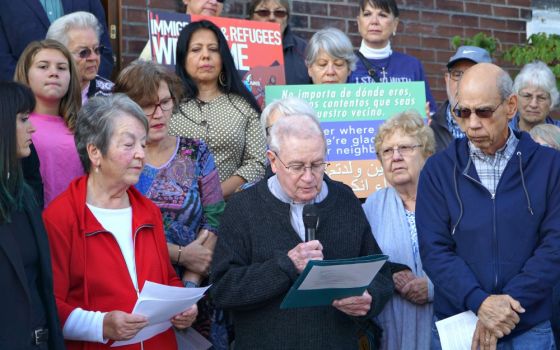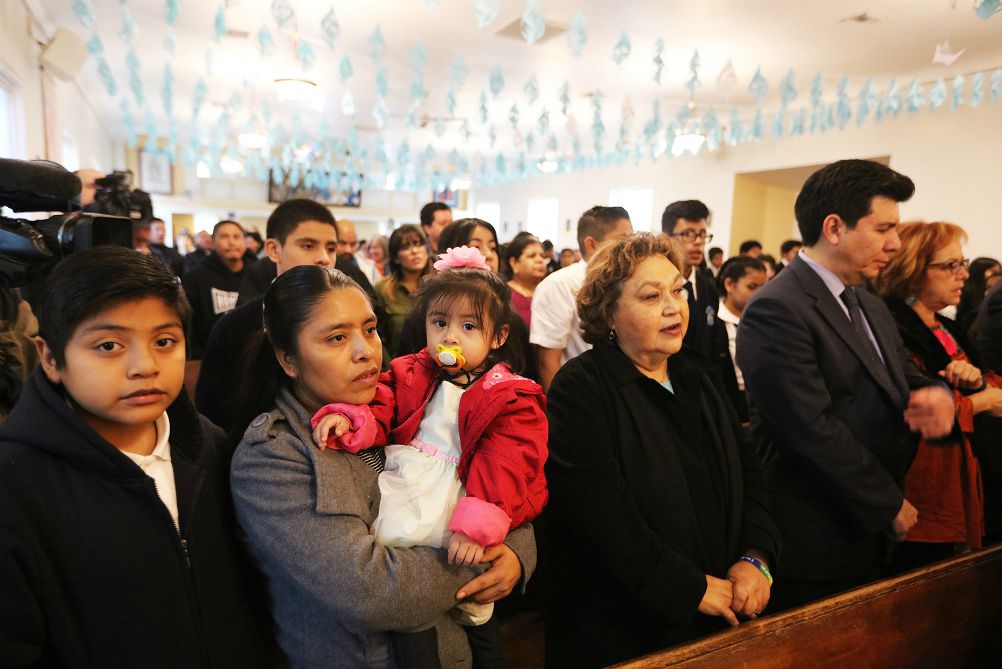
Families attend Mass Jan. 11, 2017, at Dolores Mission Church where Los Angeles Archbishop José Gomez delivered the homily message for National Migration Week. (Angelus News /Los Angeles Archdiocese/Victor Aleman)
There is an unofficial motto at Dolores Mission Church in East Los Angeles: "Just start."
Don't worry too much about finances, affirmation, implications, challenges, unknowns or inconveniences. Just start.
As long as holy discernment appears to be nodding its head, just start.
Trust in doing what is right and what needs to be done — just start — has empowered a tiny Jesuit parish in one of the poorest and most historically besieged neighborhoods of Los Angeles to carry out remarkable confrontations of gang violence, substance abuse, homelessness, poverty, hunger, lack of health care, incarceration, refugee anguish, child safety, lagging education, and even communal self-esteem.
Dolores Mission is arguably best known as the birthplace of Homeboy Industries, the now prominent intervention and rehabilitation ministry to gangs, several of which operated in the parish's Boyle Heights neighborhood when its founder, Jesuit Fr. Gregory Boyle, was named associate pastor there in 1984. Two years later he became pastor, "the youngest pastor in the history of the archdiocese," he notes in his well-known book, Tattoos on the Heart.
Today Homeboy Industries is a free-standing non-profit with its own impressive headquarters, including a bakery and popular restaurant staffed by Homeboy and Homegirl clients, about a six-minute drive from the parish. Annually, more than "10,000 former gang members from across Los Angeles come through Homeboy Industries' doors in an effort to make positive change," according to the organization's website.
Yet, while Homeboy Industries is high profile, a startling spectrum of ministries is also tap-rooted at Dolores Mission.

Pastoral associate Ellie Hidalgo stands with the stacked up cots that are used nightly for people who are homeless to sleep in the church. (NCR photo/Dan Morris-Young)
For example, shin-high scuff marks line the interior walls of the diminutive Dolores Mission Church because the cots that the 28 homeless men station around the interior to sleep on every night occasionally scrape the walls.
Pastoral associate Ellie Hidalgo calls the scuff marks "evidence of ministry."
"The homeless men and women make our church more holy," she emphasized. "They remind us of our need for a radical dependence on God" and the wisdom and insights "found in the viewpoint of the poor."
Carpeting was removed some time ago as a preventative measure against the lingering scent of that many men having spent the night in a church that can barely hold 240 worshipers.
Another 10 men bunk nightly in the parish hall, and another 10 or so in a converted parish garage. "Parish hall" is a euphemism for a much-used room about the size of a small elementary school classroom.
The men show up around 4 p.m., eat dinner at 6:30 p.m. in the Dolores Mission School cafeteria, rise at 5 a.m., and are served a 5:30 a.m. breakfast before they head out at 7 a.m. to look for work.
It has largely been this way for the past 30 years since the Guadalupe Homeless Project was initiated.
In 2015, the parish's sister non-profit, Proyecto Pastoral, expanded to include housing for 15 senior-aged women about five blocks from the church.
Some 1,250 volunteers assist in the project during the year, helping serve meals, coordinating workshops, and staffing an off-shoot distribution center which provides low-cost, gently used clothing to local residents and free clothing to shelter residents.

Dolores Mission Parish School's outdoor Mass for National Catholic Schools Week Jan. 29 (NCR photo/ Dan Morris-Young)
A parishioner since the mid-1990s, Tony Arteaga has coordinated security at the shelter for 18 years.
The native of El Salvador calls Dolores Mission a "pequeño gigante," a small giant.
"We do so much, even though we are so little, by offering sanctuary and shelter for the struggling and the weak," he said. "At the heart of Dolores Mission is the desire to give hospitality to the person without it. We are a place of refuge and protection. Dolores Mission is an angel to protect the defenseless."
Arteaga's observations mirror Boyle's. In Tattoos on the Heart, Boyle describes how "the poor in Bolivia evangelized me" in the mid-1980s which led to his requesting assignment at Dolores Mission rather than becoming director of student services at Santa Clara University.
"This was a wholly selfish decision on my part," he wrote. He had learned "the poor had some privileged delivery system for giving me access to the Gospel. Naturally, I wanted to be around this."
He got his wish in a poverty immersed neighborhood that shares his name, and he still lives with a parish Jesuit community in a residence a few blocks from the church.
Advertisement
Jesuit Fr. Michael Kennedy succeeded Boyle in 1994 and today is deeply involved in prison ministry, notably through the Jesuit Restorative Justice Initiative. Jesuit Fr. Scott Santarosa succeeded Kennedy in 2007 and currently is provincial of the Jesuits West Province.*
Jesuit Fr. Ted Gabrielli, who became pastor in 2014, had been previously assigned to Dolores Mission as a young Jesuit scholastic and was instrumental in helping Boyle and the parish community get the shelter project up and running. He also worked to establish an alternative high school for the many young people being ejected from area public schools.
What would Jesus do?
The parish's basic discernment process has been operative for at least three decades, Hidalgo said, and rests on "three guiding questions": What would Jesus do? What risks are we willing to take to do that? Can we just start?
Although Hidalgo did not join the parish leadership team until 2008, she has become familiar with "the early days when there were eight or 10 active gangs within the parish, a homicide almost weekly, gunshots heard all night."
"Those were scary and sad days when homicides were happening nearly every week and Salvadoran refugees were pouring into the city, and the Jesuits and Dolores Mission parishioners were trying to radically respond to the question, 'What would Jesus do?' and set up programs and efforts that could help," she said.

The statue of Our Lady of Guadalupe outside of Dolores Mission Church was donated by actor Martin Sheen, who was a friend of former pastor Fr. Mike Kennedy, who served 1994-2007. (NCR photo/Dan Morris-Young)
The parish had been home to two expansive public-housing projects, Pico Gardens and Aliso Village, that were largely demolished in 1999. The replacement housing is predominantly semi-detached single-family apartments.
"Mothers talk about how in those days a mom would come out of an apartment with a broom to chase away gang members or use a hose to water down the patio area so that gang members wouldn't congregate near their apartments," Hidalgo said.
Then within the settings of small Ecclesial Base Communities (Comunidades de Base), Hidalgo continued, "Fr. Greg would ask, 'What would Jesus do?' People would talk about it. Well, Jesus would learn their [gang members'] names. Little by little, there was a discerning of what Jesus would do. It requires opening one's heart and seeing in a different way. Are we looking at young monsters, or a hurting kid?"
"These were, and are, hurting and hopeless kids, often in very difficult family situations. No father or a violent step-father. Drugs and alcohol," Hidalgo said. "Our mothers began to see the needs of not just their own children, but the need to become mothers to these hurting kids, to learn their needs. 'Have you eaten today? Why aren't you in school?' They began to care about them."
When the question, "What risks are we willing to take?" began to be raised, the soil had been prepared for the roots of Homeboy Industries, she said.
Parish leaders describe the Ecclesial Base communities like pistons of prayer and reflection that power the parish.
"The Christian Base Communities … were sectors of people in the parish, mainly women, who reflected on the gospel as it impacted their real lives," Boyle writes in Tattoos on the Heart. "Their reflection compelled them to extend themselves to the gangs in their area of the projects. They would have carne asadas and other gatherings to communicate clearly to the gang members, 'You are our sons/daughters whether we brought you into this world or not.' "
Gabrielli braces a bit when asked if the Boyle Heights area can still be characterized as marked by violence, gangs and poverty.
"Those are not the markers I would use," he told NCR. "This is a community of hopes and dreams, a Boyle Heights community who welcome one another and choose to work together, to organize, to speak out against injustice, to invite others to struggle to make our world a better place. The streets of Boyle Heights are filled with children dreaming of a better future and working hard to make those dreams come true."
"One hundred percent of the people who attend Mass here," Gabrielli added, "are full of hope to provide a community of hope, hope for a better life for themselves, for their children, for their grandchildren, for their neighbors and for those whom we welcome. It is a community on fire for justice."
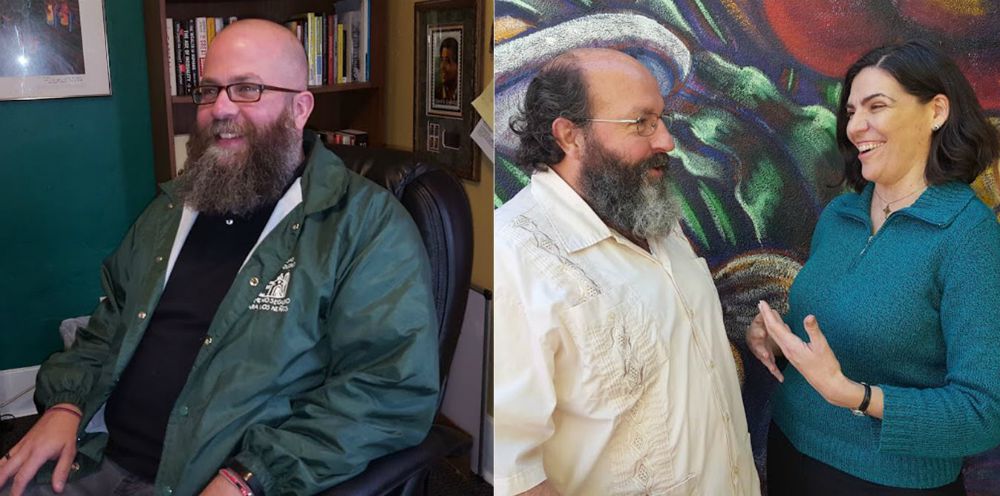
From left: Jesuit Fr. Brendan Busse, associate pastor; Jesuit Fr. Ted Gabrielli, pastor; and Ellie Hidalgo, pastoral associate (NCR photo/Dan Morris-Young)
Hard-working parish
On average about 850 parishioners attend the six weekend Masses, five of them in Spanish, one in English.
Nearly the entire congregation is of Latino/Hispanic heritage, the majority from Mexico, 20 to 25 percent from El Salvador and the balance mostly from other Central American countries.
More than half of the parish households make less than $25,000 per year; 75 percent earn less than $35,000, according to statistics compiled by the parish. All of the 250 K-8 students at Dolores Mission School qualify for subsidized lunches.
Interestingly, Hidalgo notes, about two dozen students are children of Homeboy Industries' men and women who have turned their lives around. She described a school parents' meeting at which a young father — "tattooed head to toe" — was speaking. "Not even an eyebrow was raised," she said.
The school plays a vital role in the parish and larger community, Hidalgo and Gabrielli underscored. Many of its graduates are the first in their families to have gone on to high school and graduate. Currently about 80 Dolores Mission School alumni are attending college, a high-water mark.
Fabiola is one of them. The 21-year-old is now a full-time business administration major, works two part-time jobs, and is active in the parish.
"The people here at Dolores Mission are what make it special," she said, lauding the priests and pastoral staff, and praising the "little grandmas here who look after everyone and help anyone."
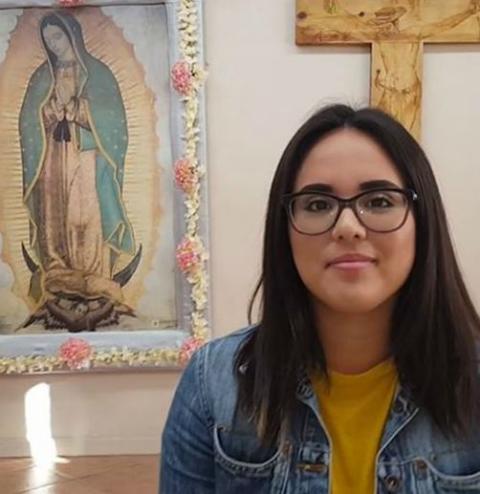
Fabiola (NCR photo/Dan Morris-Young)
"Dolores Mission is always a home and an aid to the Latino community," added Fabiola, an El Salvador native who has been in the parish since she was 4. NCR is not using her last name as a courtesy to her status. "The people here are just so supportive. They are here for everyone. They stand up for us, and we are all in the same struggle here, all sharing in each other's lives. We get one another."
Through legal help made available by the Loyola Immigrant Justice Clinic, Fabiola was able to establish legal residential status through the Deferred Action for Childhood Arrivals program. An end to the deportation forbearance it provided has been announced by the Trump administration.
The law clinic was founded at the parish in collaboration with the Loyola Marymount University Law School and Homeboy Industries. The clinic's staff provides pro bono legal counsel to parishioners and others on site. Immigration and refugee issues often dominate its calendar. Over the past six years, it has helped more than 6,000 individuals.
Gabrielli said students like Fabiola often tell him they hope to return to the parish after their education is complete and help.
But he fears those students might not be able to come back.
"Housing costs are going through the roof. But many of the young people do speak with great hope of coming back and helping lift up this neighborhood," he said. "They want to be an example for their siblings and help their neighbors and provide a way through education for hope and meeting challenges and great things to come."
No student is turned away from the parish school for lack of tuition, he said. "We will find a way to pay it."
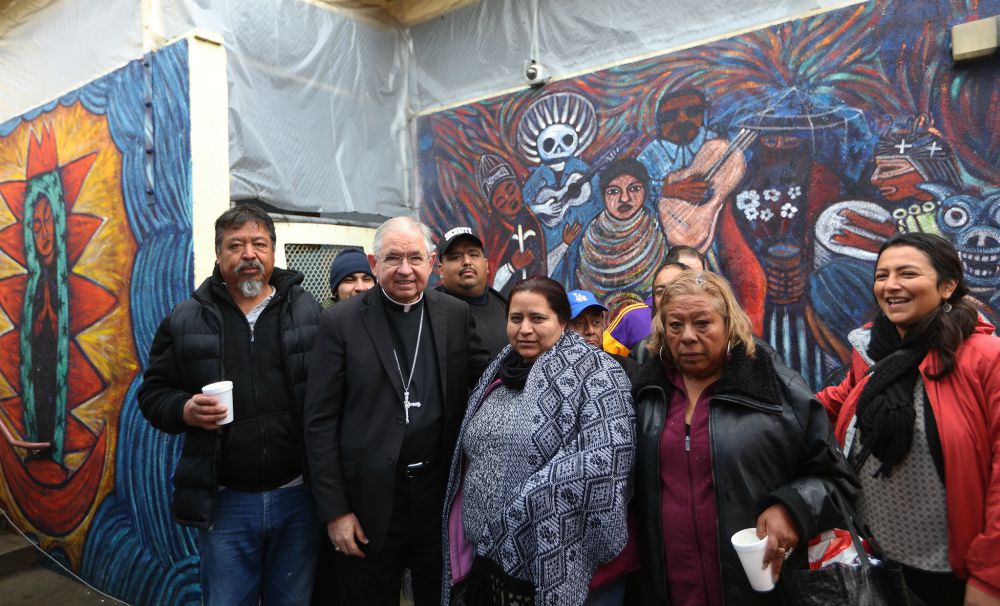
Los Angeles Archbishop José Gomez outside Dolores Mission Church, January 2017 (Angelus News /Los Angeles Archdiocese/Victor Aleman)
"It is interesting," Hidalgo, the pastoral associate, said, "that when you walk in faith, life is less about individual goals, but listening to God and to the community. It can lead to involvement in projects that we would have never thought we could do."
"It really is the poor helping the poor. Can we trust that if we just start, others will come and support us? We can't wait for the perfect business plan. We can't wait three years to have money in the bank. Can't we just start and trust that support will come?" she asked, before summarizing, "One of the things that makes Dolores Mission so special is our willingness to take the risk and just start. It is a parish of people willing to roll up their sleeves and work."
"Our parishioners are part of the hard-working poor," said Hidalgo, half or more undocumented. They "work cleaning houses, gardening, construction, hotel work, factory work, retail work, and so on."
Still, she said, an impressive 185 households made financial pledges to the parish's long-term stewardship program.
Gabrielli said he is "never surprised by the willingness" of parishioners "to step up and give more than they should, to reach out to one another, to love and care for the even more poor. It is humbling."
For example, he said, "even though we struggle to pay the bills, keep the doors open, keep the lights on, this very poor parish has chosen to reach out to others in even greater need."
The parish sends support to Casa de los Pobres in Tijuana, Mexico, where between 100 and 200 children are fed daily, Gabrielli said.
"It means a lot to our people to be able to help others in need. It is very moving, especially since I know how little our people have in reserve. They share from their own need," he said.
"We are lucky to have many friends who have come to know us over the years and who have chosen to accompany our community, to join us. They see the great commitment here and want to be part of it," Gabrielli said of backing the parish receives from outside its boundaries.
The 'just start' theory
Another example of the "just start theory" is the launch of a rare parish construction project, a two-story, 6,500-square-foot building adjacent to the school that will serve as the site for a transitional kindergarten among several other applications.
Individuals' and private foundation gifts made the undertaking possible.
These are not capricious endeavors, Hidalgo stressed, but outgrowths of the parish's discernment process.
"When we decided to build a new building, it was based on mothers wanting and needing to bring their kids to school earlier" as well as educational feedback that showed students from the area were entering school lagging in language and other skills, she explained.
"Our model is so much about listening to our parishioners, and to the Spirit, and discerning what needs to happen next," she added. "We try to do this as a parish — to listen, to understand the need, to figure out what we can do."
That commitment has led to even more than the homeless shelter projects, supporting kids in Tijuana, founding Homeboy Industries, expanding the parish school, the legal clinic, and on-going Ecclesial Base Community participation.
The parish also:
- Hosts college and high school groups from across the country for inner-city and immigrant community immersion experiences coordinated by Jesuit Volunteers. Last year, more than 30 such groups visited and individuals are often housed in parishioners' homes.
- Provides classes through a collaboration with Hand in Hand Parenting to help parents dealing with high levels of stress nurture stronger families more resilient to gang influence, substance abuse and domestic violence.
- Actively participates in faith-based community organizing such as its involvement with LA Voice-PICO to address social justice issues.
- Supports community activism on several other fronts, including affordable housing via the East Los Angeles Housing Coalition and human rights through the Coalition for Humane Immigrant Rights.
- Coordinates its health ministry with QueensCare Health, a non-profit that provides health and dental care for the low-income and uninsured.
- Developed the Safe Passage (Camino Seguro) project in collaboration with Proyecto Pastoral, a volunteer program to protect children in the community, notably their safe travel to and from school.
- Promotes restorative justice efforts for families of homicide victims as well for perpetrators and their families. Gatherings of families of perpetrators with families of victims have produced remarkable healing. Special liturgies are celebrated and support groups are encouraged.
Faith and action
Long-time parishioner Rita Chairez has been immersed in the restorative justice ministry. She lost two brothers to street violence.
A native of Mexico, Chairez said she has "never experienced anything like this community. People don't just come to Mass and then go home. They are walking in their faith, and there is so much care about people, their issues, their struggles. It is a place of faith and action, a unique community."
Several of the ministries associated with Dolores Mission are overseen by Proyecto Pastoral, the independent non-profit spun-off in 1986 by Boyle Heights residents, mostly Dolores Mission parishioners, and the Jesuits' California Province.
"People don't just come to Mass and then go home. They are walking in their faith, and there is so much care about people, their issues, their struggles. It is a place of faith and action, a unique community."
—Rita Chairez, Dolores Mission Church parishioner
—Rita Chairez, Dolores Mission Church parishioner" target="_blank">Tweet this
Its non-sectarian structure facilitates use of government grants and working with public entities, as well as providing leadership of multiple programs.
Although housed at Dolores Mission, for example, the Guadalupe Homeless Shelter administratively falls under the Proyecto umbrella.
Many of Proyecto's original "founding women," notes its website, are the same women who buoyed Boyle in the early days of Homeboy.
Proyecto initiatives include youth programs, a childcare cooperative, early learning centers, community organizing, and leadership development.
Jesuit Fr. Brendan Busse spearheads Dolores Mission's community organizing, social justice outreach and interfacing with the larger community.
Ordained last summer, the 40-year-old associate pastor describes the parish as "a place where we can come very close to God" and whose members "know what it means to be fully human."
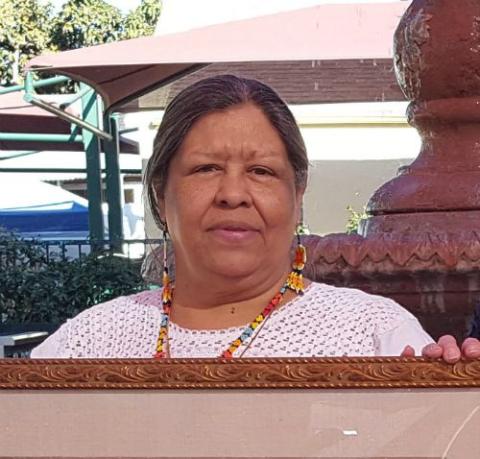
Longtime Dolores Mission parishioner Rita Chairez works in restorative justice, investing much of her time visiting persons in prison. (NCR photo/Dan Morris-Young)
"I've told many friends," he said, "that no matter what my future holds, I know that having spent some time at Dolores Mission will help me to have my priorities straight about what it means to live fully a faith that does justice, that finds God in all things and sees all things in God."
Like Gabrielli, Busse had worked in the parish in the past, once while he was a leader in Loyola Marymount's campus ministry program, later as a Jesuit novice.
He is delighted Dolores Mission is his first assignment as an ordained priest.
"Dolores Mission is the kind of place where one can see pretty clearly the complex truths of human experience. It's a place where both incredible suffering and incredible joy become credible in a million incarnate ways," Busse said.
"From the outside, people know Dolores Mission as a place that has experienced an extreme amount of suffering — poverty, racial discrimination and segregation, gang violence, waves of immigration and change. But I have found that something about that experience also opens up in people a space for incredible joy."
For example, he said, "I have not laughed harder than I did during the lunch time conversation at a recent retreat for survivors of violence. This group of women who have all lost children, siblings, partners to violence spent the morning sharing together the great weight of that pain.
"But when we got to lunch, they began telling stories about the various priests who have come through the parish. My being newly arrived, I think they wanted to assure me that everyone has their struggles at first."
One story the women shared, he said, was about a priest with faulty Spanish presiding at a funeral Mass. The priest misunderstood a whispered hint that the deceased's brother was present, and thought the brother was also dead. So, his "emotive eulogy" incorporated the live brother as if he were dead although he was sitting right there.
"In the re-telling of the story, we who had been in tears of grief all morning were now in tears of unstoppable joy, laughing and crying together while we ate lunch, in freedom."
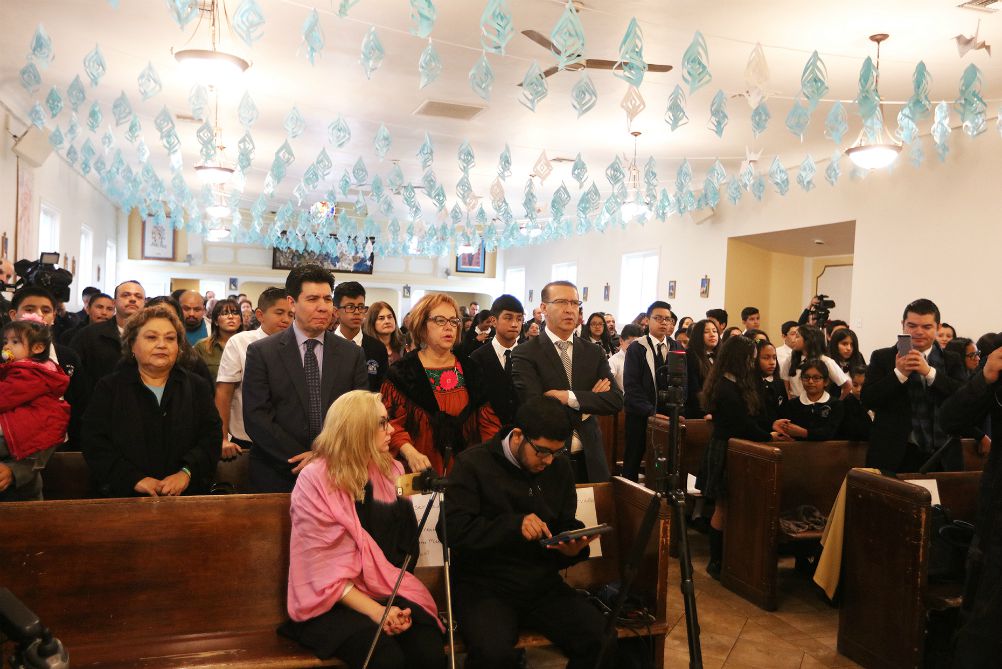
Mass at Dolores Mission Church, Jan. 11, 2017 (Angelus News /Los Angeles Archdiocese/Victor Aleman)
A 'Francis parish' before Francis
Busse, Hidalgo, Gabrielli and others will tell you that Dolores Mission "has been doing Francis long before there was a Pope Francis," in Busse's words.
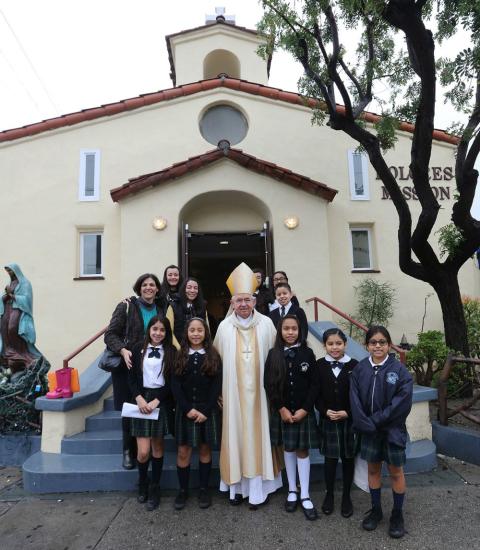
Los Angeles Archbishop José Gomez delivered his 2017 National Migration Week message at Dolores Mission Parish. Pictured with him that day is a group of Dolores Mission School students. (Angelus News /Los Angeles Archdiocese/Victor Aleman)
That said, the impact of the Latin American pope has been significant, they say.
"Francis is a great model for us," Gabrielli said. "I think we fit into the model he would like us to be — doors open wide and living the joy of the Gospel."
Parishioners see the nitty gritty of their outreach to those in need "affirmed in Pope Francis," he said.
"When the pope opened a place for people to shower, there was great excitement here because we did that many years ago," he explained. "When the pope arranged for haircuts for the homeless, we remember all the haircuts given here in our plaza. When he opened a shelter at the Vatican, our people were elated. The pope was doing ministries that our people hold so dearly."
Busse agrees. "There is a lot of resonance with Francis, his giving priority to trusting the experience of the people, for example. Dolores Mission has been modeling this understanding for a long time."
In 2015 the parish and Proyecto Pastoral were invited by ABC Television to participate in a virtual audience with Francis for some of the men and women from Guadalupe shelters. It followed an open letter from the parish to Francis in anticipation of the pope's September 2015 visit to the U.S.
The parish has a profile disproportionately large compared to its size. It has attracted significant media attention over time, including a segment on "60 Minutes." Los Angeles Archbishop José Gomez asked to use Dolore Mission as a platform for his 2017 National Migration Week address.
The visibility leads to minor misconceptions.
"People often expect us to be bigger than we are," said Hidalgo. "We are a small parish with a big heart."
"People who have not been here sometimes have preconceived notions," Gabrielli added. "It's common for some who come here for the first time to ask where the church is or where are the rest of our buildings. And then they ask how we do all that we do with so little space."
"They come with a vision of something very big. What is very big is the heart of this community."
* This story has been updated to reflect Fr. Scott Santarosa's position; the Jesuits' Oregon and California provinces combined in July 2017; he had previously been provincial of the Oregon Province.
[Dan Morris-Young is NCR's West Coast correspondent. His email is dmyoung@ncronline.org.]
We can send you an email alert every time The Field Hospital is posted. Go to this page and follow directions: Email alert sign-up.




